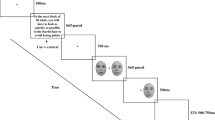Abstract
This study investigated the effects of mood induction on Stroop color-naming times for threat-related words. The subjects’ task was to color-name sets of threat-related words and affectively neutral matched control words both before and after mood-induction. Subjects were shown a short film about the medical effects of nuclear war (negative affect manipulation), a humorous cartoon, or no film. A significant and highly reliable color-naming decrement of the threat-related words was observed only after the negative affect manipulation. This indicates that the attentional bias towards the processing of threat-related material observed in clinically anxious or high Trait-Anxious subjects can be induced in initially nonanxious subjects. An incidental recall task included in the procedure provided no evidence of mood state dependent recall.
Similar content being viewed by others
References
Bentall, R. P., & Kaney S. (1989). Content specific information processing and persecutory delusions: An investigation using the emotional Stroop test.British Journal of Medical Psychology, 62, 355–364.
Bower, G. H. (1981). Mood and memory.American Psychologist, 36, 129–148.
Bower, G. H., & Mayer, J. D. (1985). Failure to replicate mood-dependent retrieval.Bulletin of the Psychonomic Society, 23, 39–42.
Buchwald, A. M., Strack, S., & Coyne, J. C. (1981). Demand characteristics and the Velten mood induction procedure.Journal of Consulting and Clinical Psychology, 49, 478–479.
Channon, S., Hemsley, D., & de Silva, P. (1988). Selective processing of food words in Anorexia Nervosa.British Journal of Clinical Psychology, 27, 259–260.
Clark, D. M. (1983). On the induction of depressed mood in the laboratory: Evaluation and comparison of the Velten and musical procedures.Advances in Behaviour Research and Therapy, 5, 27–49.
Clark, D. M., & Teasdale, J. D. (1985). Constraints on the effects of mood on memory.Journal of Personality and Social Psychology, 48, 1595–1608.
Cook, J. A. M., Jones, N., & Johnston, D. W. (1989). The effects of imminent minor surgery on the cognitive processing of health and interpersonal threat words.British Journal of Clinical Psychology, 28, 281–282.
Ehlers, A., Margraf, J., Davies, S., & Roth, W. T. (1988). Selective processing of threat cues in subjects with panic attacks.Cognition and Emotion, 2, 201–219.
Eysenck, M. W., MacLeod, C., & Mathews, A. (1987). Cognitive functioning and anxiety.Psychological Research, 49, 189–195.
Giles, M., & Cairns, E. (1989). Colour naming of violence-related words in Northern Ireland.British Journal of Clinical Psychology, 28, 87–88.
Gotlib, I. H., & McCann, C.D. (1984). Construct accessibility and depression: An examination of cognitive and affective factors.Journal of Personality and Social Psychology, 47, 427–439.
Gotlib, I. H., McLachlan, A. L., & Katz, A. N. (1988). Biases in visual attention in depressed and non-depressed individuals.Cognition and Emotion, 2, 185–200.
Green, M. W., McKenna, F. P. (1993). Developmental onset of eating related colour-naming interference.International Journal of Eating Disorders, 13: 391–397.
Isen, A. M., & Gorgoglione, J. M. (1983). Some specific effects of four affect-induction procedures.Personality and Social Psychology Bulletin, 9, 136–143.
MacLeod, C., Mathews, A., & Tata, P. (1986). Attentional bias in emotional disorders.Journal of Abnormal Psychology, 95, 15–20.
Mathews, A. (1988). Anxiety and the processing of threatening information. In V. Hamilton, G. H. Bower, & N. H. Frijda (Eds.),Cognitive perspectives on emotion and motivation. Dordrecht: Kulwer Academic.
Mathews, A., & MacLeod, C. (1985). Selective processing of threat cues in anxiety states.Behavior Research and Therapy, 23, 563–569.
Mathews, A., May, J., Mogg, K., & Eysenck, M. (1990). Attentional bias in anxiety: Selective search or defective filtering?Journal of Abnormal Psychology, 99, 166–173.
McKenna, F. P. (1986). Effects of unattended emotional stimuli on colour-naming performance.Current Psychological Research and Reviews, 5, 3–9.
McNally, R. J., Reimann, B. C., & Kim, E. (1990). Selective processing of threat cues in panic disorder.Behavior Research and Therapy, 28, 407–412.
Pearce, J., & Morley, S. (1989). An experimental investigation of the construct validity of the McGill Pain Questionnaire.Pain, 39, 115–121.
Polivy, J., & Doyle, C. (1980). Laboratory induction of mood states in the laboratory through the reading of self-referent mood statements: Affective changes or demand characteristics.Journal of Abnormal Psychology, 85, 338–340.
Power, R., & McRae, K. (1977). Characteristics of items in the Eysenck Personality Inventory which affect responses when students simulate.British Journal of Psychology, 68, 491–498.
Richards, A., & French, C. C. (1990). Central versus peripheral presentation of stimuli in an emotional Stroop task.Anxiety Research, 3, 41–49.
Stroop, J. R. (1935). Studies of interference in verbal reactions.Journal of Experimental Psychology, 18, 643–662.
Teasdale, J. D., & Taylor, R. (1981). Induced mood and accessibility of memories: An effect of mood state or of mood induction procedure.British Journal of Clinical Psychology, 20, 39–48.
Tomarken, A. J., Davidson, R. J., & Henriques, J. B. (1990). Resting frontal brain asymmetry predicts affective responses to films.Journal of Personality and Social Psychology, 59, 791–801.
Van Rooijen, L., & Vlaander, G. P. J. (1984). Dramatic induction of depressive mood.Journal of Clinical Psychology, 40, 1318–1322.
Velten, E. (1968). A laboratory task for the induction of mood states.Behavior Research and Therapy, 6, 473–482.
Vigne, J. J., Dale, J. A., & Klions, H. L. (1988). Facial electromyogram and heart rate correlates of a paradoxical attitude change to anti-nuclear war information.Perceptual and Motor Skills., 67, 755–762.
Watts, F. N., mcKenna, F. P., Sharrock, R., & Trezise, L. (1986). Colour naming of phobia-related words.British Journal of Psychology, 77, 97–108.
Williams, J. M. G., & Broadbent, K. (1986). Distraction by emotional stimuli: Use of a Stroop task with suicide attempters.British Journal of Clinical Psychology, 25, 101–110.
Author information
Authors and Affiliations
Rights and permissions
About this article
Cite this article
Green, M., Rogers, P.J. & Elliman, N.A. Change in affective state assessed by impaired color-naming of threat-related words. Current Psychology 14, 222–232 (1995). https://doi.org/10.1007/BF02686909
Accepted:
Issue Date:
DOI: https://doi.org/10.1007/BF02686909




